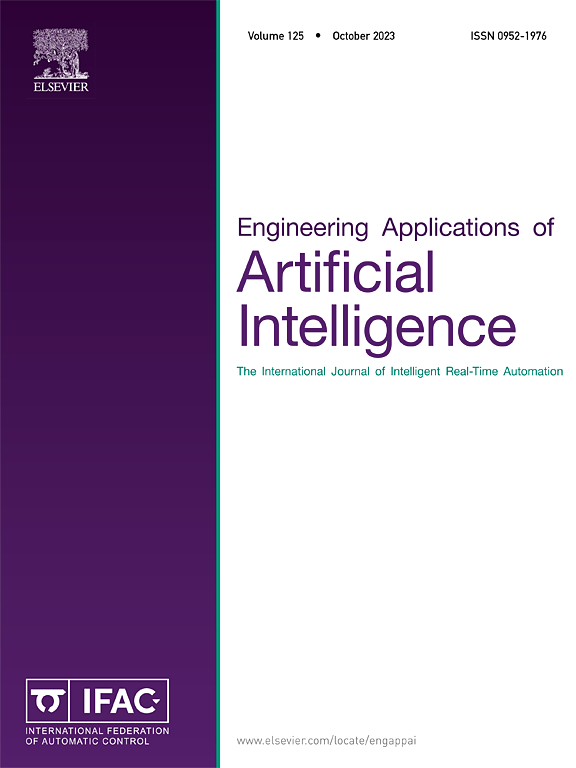Unsupervised motion-based anomaly detection with graph attention networks for industrial robots labeling
IF 8
2区 计算机科学
Q1 AUTOMATION & CONTROL SYSTEMS
Engineering Applications of Artificial Intelligence
Pub Date : 2025-02-20
DOI:10.1016/j.engappai.2025.110298
引用次数: 0
Abstract
As automated labeling on products in intelligent manufacturing grows in importance, detecting anomalies in the end-effectors used for industrial robots labeling is essential for maintaining production line stability and efficiency. Considering the distinct characteristics of specific movements in the labeling process, different motions, such as moving, labeling and rolling, contribute different effects to end-effector abnormalities. It's challenging to distinguish between normal and anomalies, instead of treating all motions as a homogeneous whole. Also, real-world industrial scenarios often lack the sufficient data on abnormal states, and resource constraints limit computation efficiency. In view of this, this paper aims to develop a task-specific anomaly detection solution tailored to the distinct motions of industrial robots labeling. To achieve this goal, an unsupervised, motion-based anomaly detection framework is proposed. The raw sensor signals from each motion are segmented and a group of encoder networks are employed to extract latent representations for each motion. Then, these motions are modeled as nodes in a graph, where a feature fusion module based on a Graph Attention Network (GAT) captures the interrelationships between them. A memory-augmented reconstruction module with multi-scale skip connections enhances the model's ability to detect anomalies. Finally, an anomaly detection module identifies abnormal states of the end-effector. Experimental validations are conducted on a dataset from real-world steel coil labeling task. The results show that the proposed framework can achieve an average performance of 98.24% with an inference time of 15 ms, also demonstrating the effectiveness of its structural design and key modules.
基于无监督运动的图关注网络异常检测在工业机器人标注中的应用
随着智能制造中产品的自动化贴标越来越重要,检测用于工业机器人贴标的末端执行器的异常对于保持生产线的稳定性和效率至关重要。考虑到贴标过程中特定动作的不同特征,不同的运动,如移动、贴标和滚动,对末端执行器异常的影响不同。要区分正常和异常,而不是将所有运动视为一个均匀的整体,这是一项挑战。此外,现实世界的工业场景往往缺乏关于异常状态的足够数据,资源约束限制了计算效率。鉴于此,本文旨在针对工业机器人标注的不同运动,开发一种针对特定任务的异常检测解决方案。为了实现这一目标,提出了一种无监督的、基于运动的异常检测框架。对来自每个运动的原始传感器信号进行分割,并使用一组编码器网络提取每个运动的潜在表示。然后,将这些运动建模为图中的节点,其中基于图注意网络(GAT)的特征融合模块捕获它们之间的相互关系。具有多尺度跳跃连接的记忆增强重建模块增强了模型检测异常的能力。最后,一个异常检测模块识别末端执行器的异常状态。在实际钢卷标注任务数据集上进行了实验验证。结果表明,该框架的平均性能为98.24%,推理时间为15 ms,也证明了其结构设计和关键模块的有效性。
本文章由计算机程序翻译,如有差异,请以英文原文为准。
求助全文
约1分钟内获得全文
求助全文
来源期刊

Engineering Applications of Artificial Intelligence
工程技术-工程:电子与电气
CiteScore
9.60
自引率
10.00%
发文量
505
审稿时长
68 days
期刊介绍:
Artificial Intelligence (AI) is pivotal in driving the fourth industrial revolution, witnessing remarkable advancements across various machine learning methodologies. AI techniques have become indispensable tools for practicing engineers, enabling them to tackle previously insurmountable challenges. Engineering Applications of Artificial Intelligence serves as a global platform for the swift dissemination of research elucidating the practical application of AI methods across all engineering disciplines. Submitted papers are expected to present novel aspects of AI utilized in real-world engineering applications, validated using publicly available datasets to ensure the replicability of research outcomes. Join us in exploring the transformative potential of AI in engineering.
 求助内容:
求助内容: 应助结果提醒方式:
应助结果提醒方式:


